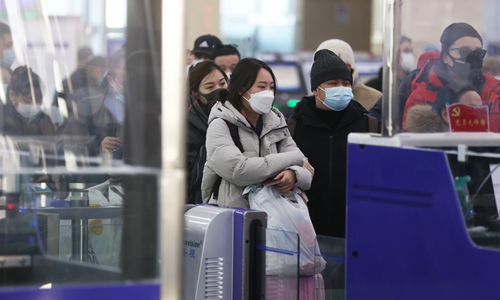
Passengers pass the customs check at Erenhot Port on Sunday as downgraded COVID-19 management was implemented on passengers. Photo: Cui Meng/GT
Major border ports in North China's Inner Mongolia and Southwest China's Yunnan on Sunday officially lifted restrictions related to COVID-19 as part of the country's new optimized management, fully resuming normal operations following pandemic disruptions in the past three years.
With port operations in full swing again, both cargo and passenger volumes on China's main land trade routes in the vast Eurasia region are expected to increase rapidly in the coming months, customs officials and businesses told the Global Times. Trade with Mongolia, Russia, Vietnam and other neighboring countries as well as those along the routes of China-Europe express freight trains will see significant growth, they noted.
At 9 am on Sunday, about 300 passengers on a bus from Mongolia entered China through the Erenhot Port in North China's Inner Mongolia under smooth border checks. "It only took an hour from the time I got on the bus to the completion of customs inspection," a passenger surnamed Zheng told the Global Times on Sunday.
Meanwhile, at the Chinese side, tourists formed a line to go through border checks before entering Mongolia. "My family hasn't taken a trip abroad in the past three years, so I decided to take my daughter on a one-day trip to Zamyn-Uud," a local resident surnamed Wang told the Global Times.
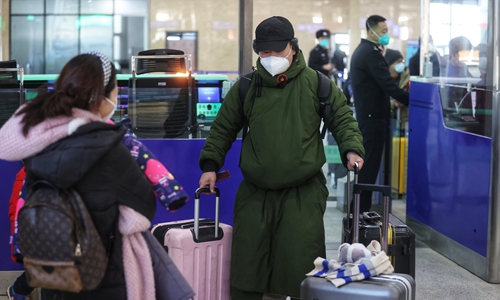
Passengers pass the customs check at Erenhot Port on Sunday as downgraded COVID-19 management was implemented on passengers. Photo: Cui Meng/GT
Erenhot is the largest land port on the China-Mongolia border and a crucial entry and exit port for one of the China-Europe freight train routes. In August, the port reached a milestone as it logged 10,000 China-Europe freight trains since the cross-border railway service via this port was launched in 2013.
As for China-Mongolia cross-border trade, trade via Erenhot accounts for more than 70 percent of the total.
With the port resuming full operations without COVID restrictions, many are expecting significant growth in both cargo and passenger volume.
"After controls are loosened, road freight will return to normal, and railway freight will have more capacity. It is expected that there will be significant growth in China-Europe freight trains next year," Wang Mailigeng, a representative of Erenhot Customs, told the Global Times on Sunday.
Some traders are expecting a recovery to pre-pandemic levels very soon. "At present, overseas demand is high, and it is expected that it will return to the pre-pandemic level quickly," said Liu Yang, general manager of logistics firm Sinotrans' Erenhot branch.
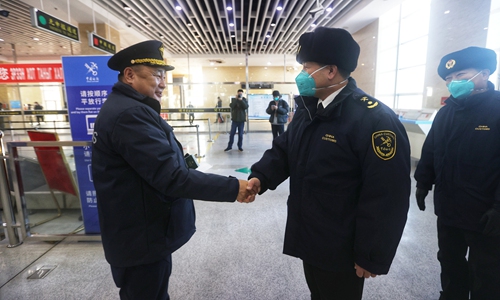
Customs officials from China and Mongolia greet each other at the Erenhot Port on Sunday. Photo: Cui Meng/GT
In Manzhouli, Inner Mongolia, another land port, international road passenger services resumed on Sunday, with 16 passengers from China entering Russia and six passengers from Russia entering China on the first two buses after the lifting of the anti-COVID measures, according to an official statement from the local customs department sent to the Global Times.
Similar resumption of operations is seen at ports on China's southern border. In Hekou, a major land port in Southwest China's Yunnan Province, cross-border travel between China and Vietnam resumed at 8 am on Sunday. The port recorded a daily tally of people flows of 124,000 at peak levels before the COVID-19, said Yang Huijianxiong, director of the port office of the Hekou government.
Over the past three years, the pedestrian checkpoint was closed while the other checkpoint of the port that allows for cargo shipping remained open.
The pandemic's fallout on cargo transport was tangible. Last year, cargo shipped through the port was estimated to reach 2 million tons, well below its peak levels of 6 million tons, Yang said. He expected the 2023 number to swiftly rebound to 6 million tons.
Not long after the official opening, streams of people were seen entering China after crossing a highway bridge that connects Hekou with Vietnam's northern Lao Cai Province.
After a brief ceremony in front of the Nanxihe highway port at around 10 am that marked the resumption of China-Vietnam cross-border travel, long lines of people were seen waiting to cross the border.
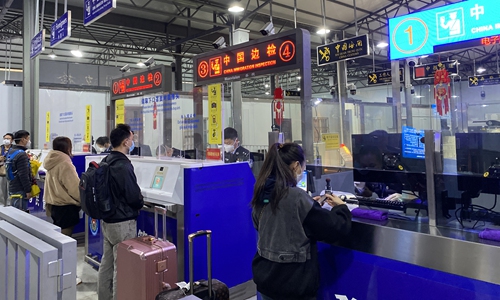
Passengers pass through the Hekou port, a major land port in Southwest China's Yunnan Province adjacent to Vietnam, on January 8, 2023, the first day of China's downgraded COVID-19 management. Photo: Li Qiaoyi/GT
Zhou Qiling, hailing from the Hekou Yao Autonomous County where the port is located, was among the first batch of travelers to relish the border opening.
As a frequent traveler to Vietnam, Zhou missed the previous happy moments intensely but had her travel halted for the past three years, she told the Global Times on Sunday.
Now she was thrilled to be able to visit Vietnam again, where Sapa, a mountainous resort in Lao Cai known for French-style buildings, is on her top-to-visit list.
Liang Bo, deputy chief of the culture and tourism bureau in Hekou, told the Global Times on Sunday that local cross-border travel is on track to recover to pre-virus levels.
Hekou plans to increase bilateral exchanges and cooperation between China and Vietnam, mull over the joint creation of a border travel pilot zone, a cross-border travel cooperation zone, and ramp up the availability of cross-border self-driving tours, among wide-ranging efforts to boost local appeal to tourists, according to Yu.
In Northwest China's Xinjiang, four major road ports, including Khorgos on the border with Kazakhstan, also resumed cross-border passenger services on Sunday, according to local media reports.
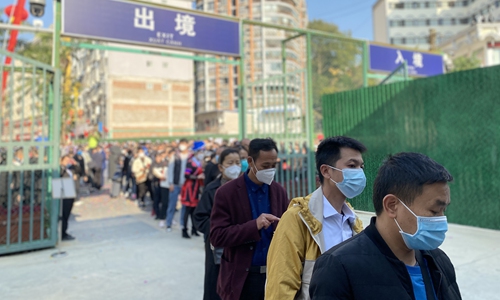
Passengers pass through the Hekou port, a major land port in Southwest China's Yunnan Province adjacent to Vietnam, on January 8, 2023, the first day of China's downgraded COVID-19 management. Photo: Li Qiaoyi/GT








